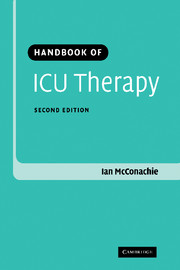Book contents
- Frontmatter
- Contents
- List of contributors
- Preface
- Part I Basic principles
- 1 Cardiac function, monitoring, oxygen transport
- 2 Shock
- 3 Oxygen therapy
- 4 Central venous access
- 5 Fluid therapy in ICU
- 6 Anaemia and blood transfusion
- 7 Nutrition
- 8 Non-invasive mechanical ventilation
- 9 Principles of IPPV
- 10 Modes of ventilation and ventilatory strategies
- 11 Weaning and tracheostomy
- 12 Vasoactive drugs
- 13 Infection and infection control
- 14 Sedation, analgesia and neuromuscular blockade
- 15 Continuous renal replacement therapy
- 16 Withholding and withdrawing therapy in the ICU
- Part II Specific problems
- Index
11 - Weaning and tracheostomy
Published online by Cambridge University Press: 24 August 2009
- Frontmatter
- Contents
- List of contributors
- Preface
- Part I Basic principles
- 1 Cardiac function, monitoring, oxygen transport
- 2 Shock
- 3 Oxygen therapy
- 4 Central venous access
- 5 Fluid therapy in ICU
- 6 Anaemia and blood transfusion
- 7 Nutrition
- 8 Non-invasive mechanical ventilation
- 9 Principles of IPPV
- 10 Modes of ventilation and ventilatory strategies
- 11 Weaning and tracheostomy
- 12 Vasoactive drugs
- 13 Infection and infection control
- 14 Sedation, analgesia and neuromuscular blockade
- 15 Continuous renal replacement therapy
- 16 Withholding and withdrawing therapy in the ICU
- Part II Specific problems
- Index
Summary
The key points of this chapter are as follows:
Mechanical ventilation (MV) is a life-saving procedure but it can also be harmful. Some of the side effects are related to the presence of an endotracheal tube.
Separating the critically ill patient from the ventilator is referred to as “weaning”.
It is crucial to discontinue ventilatory support and extubate at the earliest opportunity that a patient can sustain spontaneous ventilation safely.
Over 40% of the time that a patient receives MV is spent in weaning.
The most important indicator of readiness for weaning is resolution of the acute event which necessitated ventilation.
For the majority of patients, especially those requiring short-term respiratory support, MV can be removed safely and easily. However, in those recovering from serious illness or respiratory failure, discontinuation may be associated with considerable difficulty. Few guidelines exist for the optimal approach to this problem.
Before attempting the weaning process, it is important to satisfy various preconditions related to the patient's general state:
absence of major organ or system failure, in particular, a stable cardiovascular system;
no severe abdominal distension;
absence of fluid, acid-base or electrolyte imbalance;
adequate nutrition;
correction of pain and anaemia;
cooperative patient with minimal sedation.
- Type
- Chapter
- Information
- Handbook of ICU Therapy , pp. 134 - 145Publisher: Cambridge University PressPrint publication year: 2006

